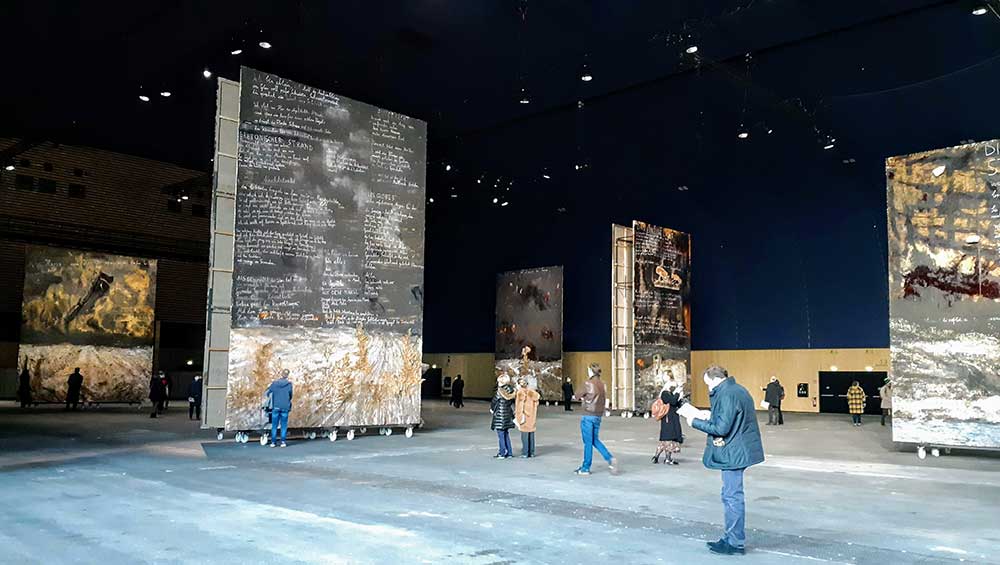
Anselm Kiefer: Pour Paul Celan, Grand Palais Éphémère, Paris. Photo: Ana Beatriz Duarte.
Grand Palais Éphémère, Paris
17 December 2021 – 11 January 2022
by ANA BEATRIZ DUARTE
“To write poetry after Auschwitz is barbaric,” Theodor Adorno wrote in 1949. Poetry, though, is exactly what Paul Celan chose for his account of the barbarism of the Nazi regime. Now considered one of the greatest 20th-century poets of the German language, Celan experienced the horrors of the concentration camps, having been forced to work at one and having lost his parents at another. In the words of Anselm Kiefer, who now presents the exhibition For Paul Celan, at the Grand Palais Éphémère, in Paris: “Celan does not merely contemplate nothingness; he has experienced it, lived through it.” The artist goes even further and affirms that “only poems are real … [They are] matter in the abyss of antimatter.”1
The exhibition at the Grand Palais Éphémère (temporary Grand Palace) is itself ephemeral: on for just four weeks. It is accompanied by a book-catalogue with texts by Chris Dercon, the exhibition’s curator and director at the Réunion des Musées Nationaux Grand-Palais, who commissioned the works, the artist Edmund de Waal, the philosopher Emanuele Coccia, the film-maker Alexander Kluge and the curator Ulrich Wilmes. A highlight of the book, though, are the extracts from Kiefer’s journal during the time he was preparing the works at For Paul Celan, in which he reflects on Celan’s work and his own process as if chatting to himself.
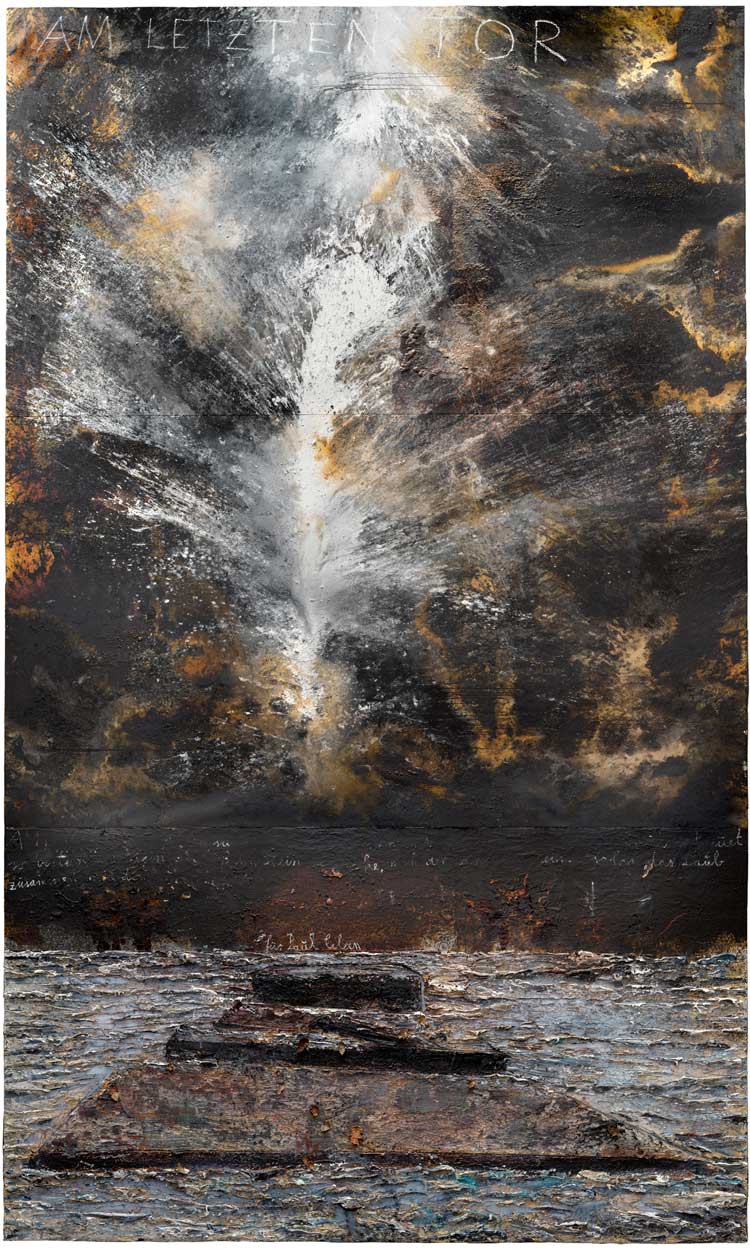
Anselm Kiefer. Am Letzten Tor (At the Final Gate), 2020-21. Emulsion, acrylic, oil, shellac and chalk on canvas, 840 x 470 cm. Copyright: © Anselm Kiefer. Photo: Georges Poncet.
Celan was born Paul Antschel (pronounced Ancel, from which comes the French-sounding anagram Celan), in 1920 in Romania, to a German-speaking Jewish family. He moved to France in 1948, shortly after publication of the poem for which he is probably most famous, Todesfuge (Death Fugue), then named Death Tango, which would later make a lasting impression on Kiefer. In the poem, one can find the seeds of what Celan would develop in his late work, an attempt to deprive language of all its given meanings, violently reinventing German, his mother language as well as that of the Nazis: “Death is a master from Germany, his eye is blue,” read an extract from Todesfuge.
In 1970, Celan threw himself into the Seine and drowned. Kiefer, who had been born in Germany in March 1945, not long before the end of the second world war, was then 25, and Celan had been a constant presence in his work since the painter’s adolescence. Kiefer had spent his childhood near the French border. At that time, he says, nobody spoke of the Holocaust.
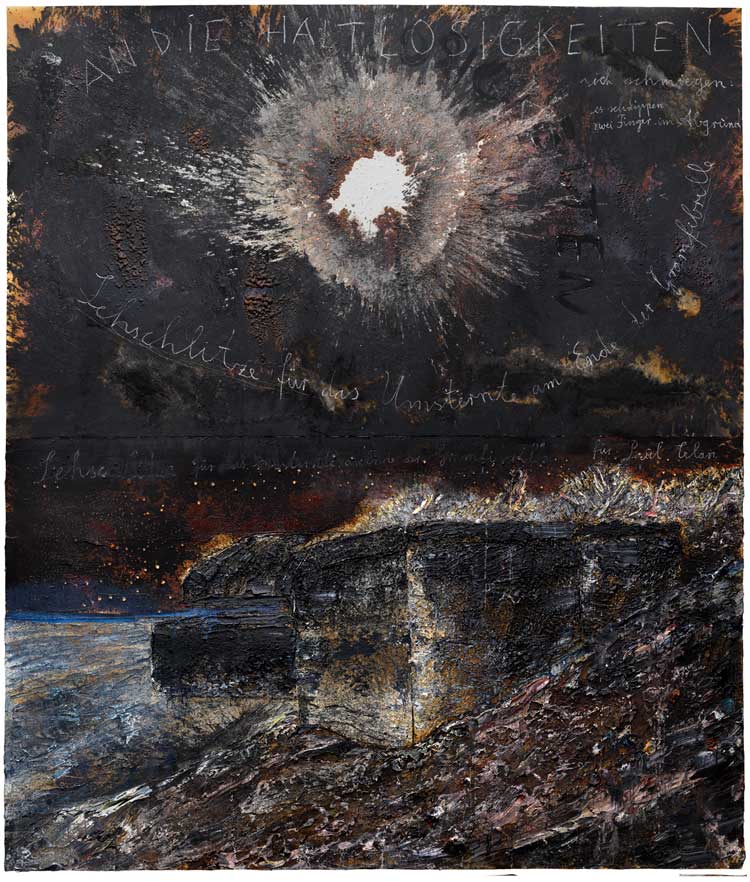
Anselm Kiefer. An Die Haltlosigkeit à L’Infixe (To cling), 2021. Emulsion, acrylic, oil, shellac, and chalk on canvas, 560 x 470 cm. Copyright: © Anselm Kiefer. Photo: Georges Poncet.
In the early 90s, like Celan many years before, Kiefer moved to France, where he has lived and worked ever since. More than a French citizen, he has also become a French monument. The word, of course, refers to the huge scale of most of his work, as well as to the fact that he has been commissioned to make permanent works at the Louvre Museum, for example. Also, the French authorities have just approved a plan to incorporate contemporary art in the redesigned Notre Dame Cathedral, and Kiefer’s name is one of those put forward as a possible artist.
Celan’s poems have not just been mere inspiration for Kiefer. They are his raw material, to which he gives concrete existence. “You erect the poem in front of you like a tree (a thought at tree height); you can take shelter below like in a forest. You write the poem in one of your paintings, you edit it, so to speak. The writing lines follow existing lines, the elevations and hollows of the pictorial layer. They insert themselves into it, lean into it, they incorporate themselves into it with tenderness …,” he says in his journal (3 July 2021, Saturday, 20h 18), adding: “It is not an attempt at appropriation, but almost already a ritual. Not a game. The ritual is linked to time, to history.”
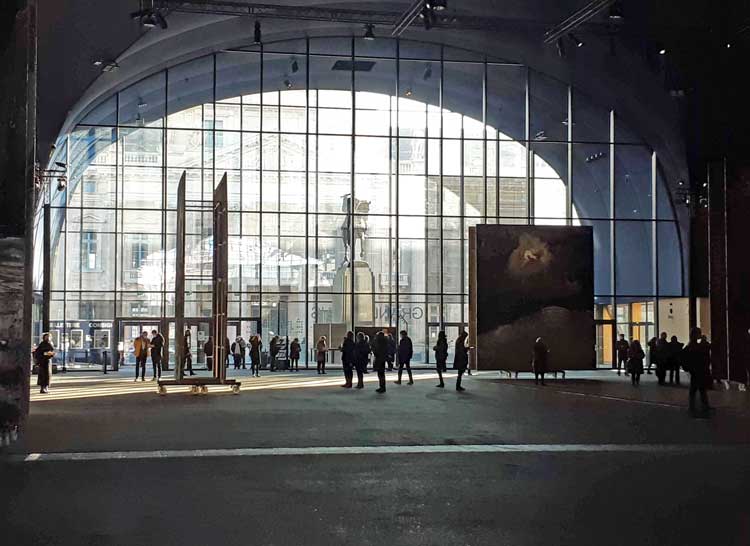
Anselm Kiefer: Pour Paul Celan, Grand Palais Éphémère, Paris. Photo: Ana Beatriz Duarte.
Celan’s words become traces of the memories they evoke. As lines of poetry, they are also pieces of drawings. Kiefer places them over dark skies, at the top of very high canvases, giving them a second (material) life. What was once verbal becomes visual. The words are part of the piece, not metadata outside it. Even the title Für Paul Celan features within the pictorial space rather than on a label next to the work. It is hard to really read the poems – not only for the non-German speakers – as they are high up, integrated into the landscape.
Landscapes are common in Kiefer’s art, painted in perspective, such as in the stunning central, and largest, work at The Grand Palais, As an Ark It Left the Road (2020-21), in which lines converge to a vanishing point occupied by what appears to be a wooden boat. The landscapes reveal an apocalyptic world in which time has stopped: an after-time.
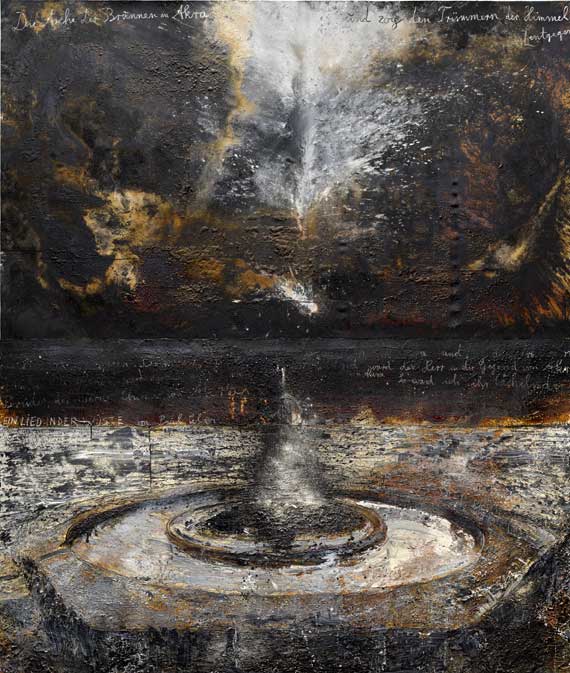
Anselm Kiefer. Die Asche der Brunnen von Akra (The Ash of the Wells of Accra), 2020-21. Emulsion, acrylic, oil, shellac and chalk on canvas, 560 x 470 cm. Copyright: © Anselm Kiefer. Photo: Georges Poncet.
It is also a world almost devoid of colour but not of light. In Because You Found the Woe-Shard (2018-21), On the Sharp Point (2020-21), Obstructive Tomorrow (2020-21), From Heart and Brains the Stalks of the Night are Sprouting (2018-21) and At the Final Gate (2020-21), for example, golden light emerges from and contrasts with dark monochrome. In other paintings, light itself is the main theme, such as in The Only Light (2019-21), and is also suggested at in To Cling (2021), The Ash of the Wells of Accra (2020-21), and others, resembling explosions and lightning. The references to destruction but also to a renewed future time are clear.
Two paintings are named after Celan’s poem The Secret of the Ferns, with the fern itself painted in gold. While one reproduces the poem’s lines, the other depicts a spiral drawn according to the golden ratio, a mathematical calculation widely used throughout art history since the Renaissance.
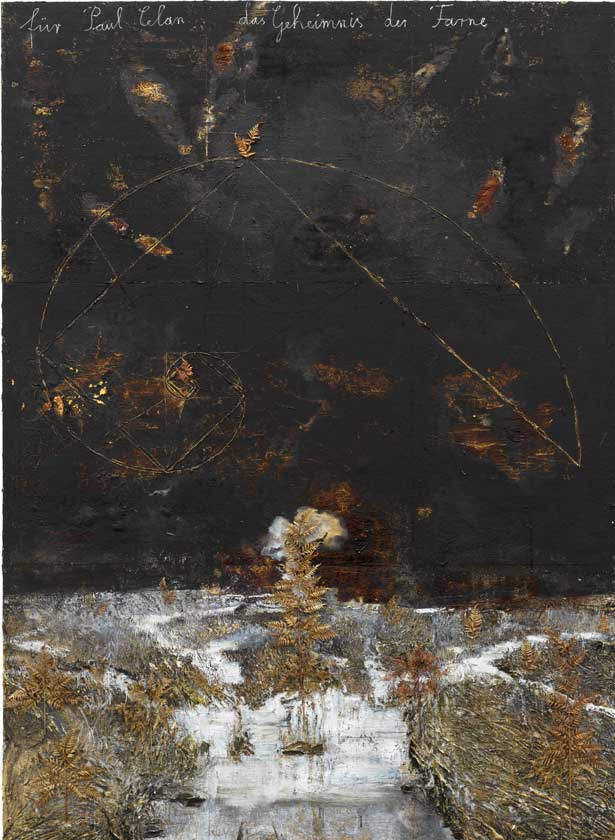
Anselm Kiefer. Für Paul Celan - das Geheimnis der Farne (For Paul Celan – Secret of the Ferns), 2021. Emulsion, acrylic, oil, shellac, metal, resin and chalk on canvas, 840 x 570 cm. Copyright: © Anselm Kiefer. Photo: Georges Poncet.
Another spiral appears on the impressive Just Think – The Peat-Bog Soldier (2018-21), positioned at the dark, right-end corner of the exhibition space and named after a song written by prisoners in Nazi labour camps. Here, straw is substituted for human flesh in a line of soldiers beneath a dusky sky where a real cart full of stones is placed over the central point of the spiral and of the upper half of the canvas.
There is not one single viewing point but many from which the works can be observed and, as well as looking at the works from a distance, most visitors get up close to them, at which point they are obliged tolook upwards. The scale of the canvases is intimidating. From this distance, they can inspect details: the painting becomes an abstraction composed of lines drawn with straw, for example, and volumes of paint galore and stones or plants.
Kiefer is not really a painter. Rather, his canvases are three-dimensional objects where ink itself has volume and is sculpted on. His pieces are saturated, too, with other matter – flowers, ferns, straw, stones, sand, glass, rust and ash – in different stages of metamorphosis, a cycle of destruction and renaissance, evoking the idea of an end. Rubble and ruins are layers of memory, an essential element to recreate history, Kiefer believes.
Some of the materials he uses relate directly to Celan’s poetry, the most significant probably being ash. In his journal, Kiefer notes that ash can be “an allusion to soap made in Auschwitz from the ashes of cremated people”, and continues: “Ash flowers: the union of two opposites, as often in Celan’s poems” (22 June 2021, Tuesday).
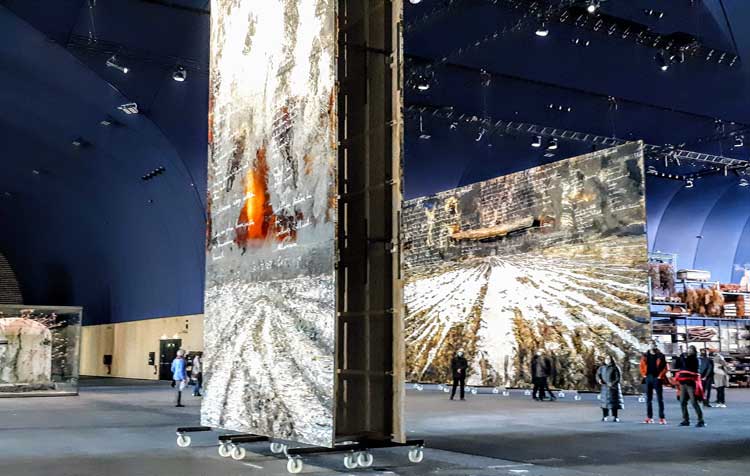
Anselm Kiefer: Pour Paul Celan, Grand Palais Éphémère, Paris. Photo: Ana Beatriz Duarte.
Many of these materials are the subject of the work, as evidenced in titles such as Secret of the Ferns, Poppy and Memory and The Bright Stones. Apart from that, secondary words in the titles, such as “only”, “night”, “swamp” and “shard”, help to conjure a sombre ambience of deprivation and scarcity.
At the Grand Palais Éphémère, visitors get the opportunity to see Kiefer’s collection of otherwise disposable materials, fragments and leftovers from his atelier, classified and stored on gigantic shelves facing the Eiffel Tower. They are meaningfully named Arsenal, displayed as artwork itself. Ferns and other plants used in the paintings are there, as well as elements from other works.
The 19 vast canvases (about 10 metres high, some horizontal, but most of them vertical) are displayed on wheeled racks in no specific order and with no walls in between. The visitor can inspect the backs of the works since there is nothing to hide the raw structures. And despite their size and weight, the huge, vertical formats give them a lightness: seeming to touch the ceilings of this tall building, they appear ready to fly. On the rare sunny mornings one gets in Paris at this time of year, the unexpected light gives new colours to otherwise sober paintings.
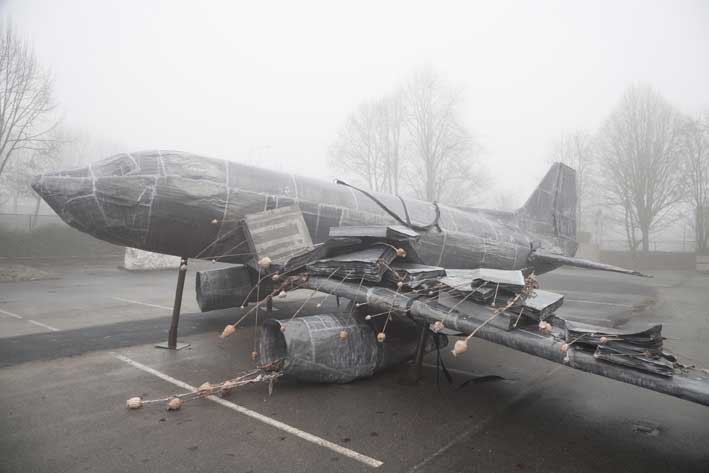
Anselm Kiefer. Mohn und Gedächtnis (Poppy and Memory), 2016. Steel, zinc, lead, resin and shellac, 320 x 100 x 1360 cm. Copyright: © Anselm Kiefer. Photo: © Anselm Kiefer.
As well as the paintings, four installations are integrated in For Paul Celan, one being a simulacrum of Kiefer’s atelier. An aeroplane draws the public’s attention: a clear reference to the war in a place that itself resembles a hangar. Made of lead, it cannot fly. Poppies, known for their hallucinogenic properties and also another reference to Celan’s poetry, intersect the wings as if arrows or projectiles. Next to them lay unidentified books, also made of lead. Next to the plane is another sign of the war: a bunker, again intersected with poppies. The solid structure is placed inside a human-sized display case made of glass, as if to isolate and protect a delicate piece.
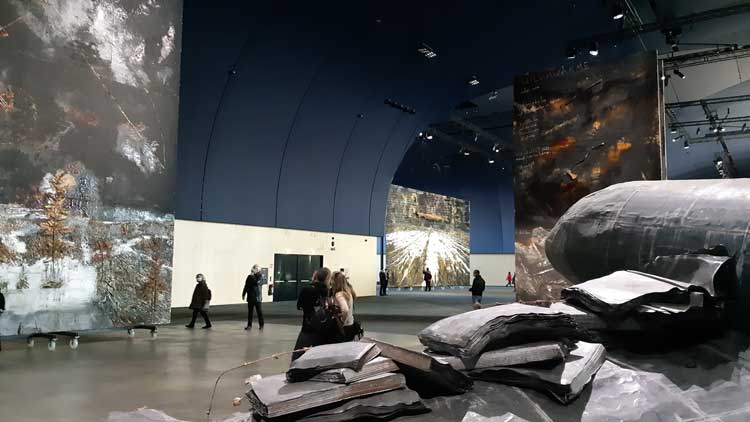
Anselm Kiefer: Pour Paul Celan, Grand Palais Éphémère, Paris. Photo: Ana Beatriz Duarte.
At a dark corner of the enormous building lies a recreated work from the 1960s. Occupations is a container with three narrow corridors inside. The visitor enters from one side and leaves at another. Along the corridors, faded photos, stained by the passage of time and by the hands of the artist himself, show spectral human figures (Kiefer himself, dressed in military uniform) at gloomy symbolic landscapes and monuments. The people in the pictures are remains or traces of people, presences no longer there. Everything is rough, harsh. In different ways, it is uncomfortable to see. Outside, one can read Celan’s Wolf’s-Bean, in which the poet addresses his parents’ deaths in concentration camps.
In his journal, Kiefer analyses his approach to pictures: “When I look at a photo that could potentially become a painting, I first have to disregard what is exclusively related to the instant that the shutter is released, and come to what the photo really sparked in me. Many things that have accompanied this moment must be destroyed. It remains ‘genicht’ (‘annihilated’), as Celan writes” (9 July 2021, Friday, 10h 22).
Although Kiefer has been working on Celan’s poetry since the 70s, he has never previously dedicated a show exclusively to him. He is the first artist to occupy the whole of the Grand Palais Éphémère, I enormous temporary structure with 10,000m2 floor space, built on a site at the base of the Eiffel Tower, for use while the original Grand Palais is being restored.
Though the dimensions of the space might have set Kiefer at his ease, given the gigantic length of his own atelier in southern France, the challenge of paying homage to one of his main intellectual references was not without its challenges: “How can you put Celan in a room built for the Olympics? Isn’t that an impossible, blasphemous undertaking?”, Kiefer asks himself in his journal. And adds: “You should burn the paintings on the spot and say: they were insufficient” (28 June 2021, 13h 45). An earlier quote from his journal seems to add to this thought: “When I start working on a composition, I already know that it will be destroyed. It can never meet my demands and has to be destroyed over and over again” (20 June 2021, Sunday, 11h 18).
In Kiefer’s creative process, the pieces are never finished. At times, he revisits old ones adding new elements. As he put it during his conference at Collège de France:1 “Often I shut paintings away in a dark storage space for many long years … [until] they manage to muster enough strength to attract attention to themselves. After having freed a painting from the dark, I repaint it and a transition towards another state of being takes place.”
For the current exhibition, apart from the new works, he has reworked paintings first conceived as early as 2015. Just like Celan, Kiefer rebuilds from his wrecks to start a new cycle. It is not the end, but the past and the future linked by a vortices. And just as in postwar Europe, during Kiefer’s childhood, when ruins were commonplace, destruction is for him a fertile ground from which something new can arise.
References
1. L’Art Survivra à Ses Ruines (Art Will Survive Its Ruins) by Anselm Kiefer, published by Editions du Regard, 2011.